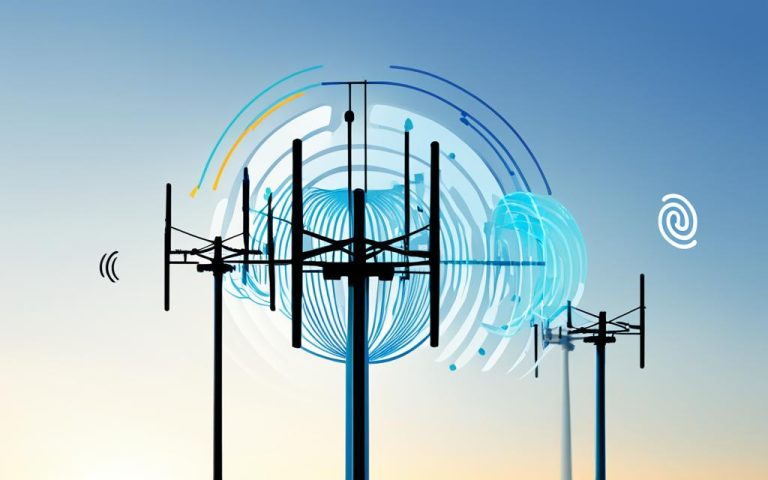In rural areas across the United States, access to reliable internet can be a major challenge. According to a survey from the Pew Research Center, only 72% of people living in rural areas have broadband internet access at home. This lack of access has implications for education, healthcare, and economic opportunities. To bridge this digital divide, fixed wireless access (FWA) offers a promising solution.
FWA technology establishes wireless connections between fixed points, such as cell towers and individual antennas, to provide internet service. Unlike traditional methods like DSL or satellite, FWA offers lower costs, streamlined deployment, and the ability to quickly adjust capacity.
By leveraging FWA, rural areas can bring high-speed internet access to their residents, enabling them to fully participate in the digital age. Whether it’s accessing online education resources, telehealth services, or running online businesses, FWA can bridge the rural connectivity gap.
The Need for Improved Rural Internet Service
The availability of reliable internet access in rural areas has been a concern for years, but the COVID-19 pandemic further emphasized the urgency of finding a solution. Access to high-speed internet is crucial not just for buying products and streaming services, but also for accessing key services like healthcare, education, and remote working.
The lack of broadband connectivity in rural areas is a major problem, with 42 million people in the US unable to purchase broadband internet due to unavailability or affordability issues. The Infrastructure Investment and Jobs Act and the US Department of Agriculture’s ReConnect Program are initiatives aimed at improving rural internet service.
Fixed wireless access (FWA) can play a critical role in expanding connectivity in these areas. FWA provides internet service through wireless links between fixed points, such as cell towers and individual antennas, eliminating the need for extensive physical infrastructure. It offers a cost-effective and reliable solution to bridge the digital divide and enhance rural connectivity.
The Impact of Limited Broadband Availability
The limited broadband availability in rural areas has significant implications for individuals and communities. Without high-speed internet access, rural residents are disadvantaged in various aspects of their lives. Here are some key consequences:
- Limited access to healthcare services, including telemedicine consultations and online appointment bookings.
- Reduced educational opportunities, with limited access to online learning resources and remote education options.
- Challenges in telecommuting and remote working, hindering economic growth and job opportunities.
- Difficulty in accessing government services and online civic engagement.
- Reduced competitiveness for rural businesses in the digital economy.
The Importance of Broadband for Rural Communities
Improving rural internet service is not just about convenience; it is a necessity for rural communities to thrive in the digital age. Here are some key reasons why high-speed internet is vital:
- Economic Growth: Access to broadband enables rural businesses to expand their customer base, promote online services, and drive economic growth.
- Education: High-speed internet allows students in rural areas to access online educational resources, collaborate with peers, and participate in virtual learning experiences.
- Healthcare: Telemedicine services and remote patient monitoring become accessible, improving healthcare outcomes for rural residents.
- Quality of Life: Access to entertainment, social media, and online communities connects rural residents to the world, reducing isolation and enhancing quality of life.
“Broadband access is no longer a luxury; it is essential infrastructure for rural communities to thrive in the digital age.”
The need for improved rural internet service is undeniable. Initiatives like the Infrastructure Investment and Jobs Act and the ReConnect Program are steps in the right direction. However, fixed wireless access (FWA) can provide an immediate and practical solution to the broadband availability problem in rural areas. By leveraging wireless technology to connect rural communities, FWA can bring high-speed internet to underserved areas, empowering individuals, businesses, and communities with the digital tools they need to thrive.
Benefits of Fixed Wireless Access
Fixed wireless access (FWA) is a technology that brings numerous benefits to rural internet users. Implementing FWA can provide cost-effective solutions by minimizing the need for additional infrastructure, such as physical cables or fiber, to reach every location. This streamlined approach not only lowers costs but also makes broadband more accessible to rural areas.
One of the key advantages of FWA is its simplified deployment process. Instead of waiting for a technician, customers can easily install the service themselves, saving time and reducing the hassle of scheduling appointments. This streamlined deployment enables quicker access to reliable internet connectivity, ensuring rural residents can stay connected without unnecessary delays.
FWA also leverages the advancements in 5G technology, delivering enhanced network efficiency. With its ability to adjust download and upload capacity quickly and easily, FWA offers flexibility without requiring on-site technician visits. This network efficiency allows for seamless connectivity and ensures optimal performance for rural customers.
Advantages of Fixed Wireless Access:
- Cost-effective solution for rural areas
- Minimizes the need for additional infrastructure
- Streamlined deployment process
- Enables self-installation by customers
- Enhanced network efficiency through 5G technology

As the demand for reliable internet connectivity in rural areas continues to grow, fixed wireless access (FWA) serves as a reliable and efficient option for bridging the rural-urban digital divide. With its lower costs, streamlined deployment, and network efficiency, FWA is paving the way for improved connectivity in rural communities.
How FWA Benefits Rural Businesses
Fixed wireless access (FWA) offers significant benefits for rural businesses, empowering them with the tools and resources necessary for success in today’s digital age. From data-driven agricultural practices to expanding online services, FWA has become a game-changer for rural small businesses.
Data-Driven Agricultural Practices
FWA enables farmers to harness the power of data-driven agricultural practices, revolutionizing the way they operate. By connecting to real-time weather data, crop monitoring systems, and remote equipment control, farmers can make informed decisions, optimize resource usage, and improve overall efficiency. This connectivity promotes more sustainable farming practices and enhances productivity, ensuring a brighter future for the agricultural industry.
Expansion of Online Services
Rural small businesses often face challenges when it comes to reaching a larger customer base due to geographical limitations. However, FWA bridges this gap by providing reliable internet connectivity. With FWA, rural businesses can offer their products and services online, unlocking new opportunities for growth and revenue generation. By embracing digital tools and platforms, rural small businesses can tap into a global market, increase sales potential, and create a competitive edge.
According to a study by the Atlantic Council, the full adoption of digital technologies by rural small businesses could result in billions of dollars in sales per year and the creation of thousands of jobs. FWA plays a pivotal role in enabling this digital transformation, unleashing the potential of rural entrepreneurship and economic growth.
Backup and Failover Option
Reliable internet connectivity is crucial for businesses that heavily rely on online services and communications. FWA acts as a robust backup and failover option for businesses, ensuring uninterrupted operations even in the event of an internet outage. With FWA, businesses can maintain continuity, seamlessly switch to a secondary connection, and avoid costly downtime.
These are just a few examples of how FWA benefits rural businesses. By leveraging this technology, businesses can embrace digital innovation, expand their reach, and thrive in the increasingly interconnected world of commerce.
| Benefits of FWA for Rural Businesses | Description |
|---|---|
| Enhanced Efficiency | Connectivity to real-time data allows for more informed decision-making and optimized resource utilization, improving overall efficiency in agricultural practices. |
| Expanded Customer Base | FWA enables rural small businesses to offer products and services online, unlocking new market opportunities and expanding their customer reach beyond geographical limitations. |
| Economic Growth | Rural small businesses embracing digital tools can tap into a global market, potentially leading to billions of dollars in sales and the creation of thousands of jobs. |
| Backup Connectivity | FWA serves as a reliable backup and failover option, ensuring uninterrupted operations for businesses that heavily rely on internet connectivity. |
FWA vs. Other Broadband Technologies
Fixed wireless access (FWA) is a viable alternative to other broadband technologies such as fiber-optic cables, satellite internet, and 4G/5G networks. While each technology has its own advantages and disadvantages, FWA offers a cost-effective and reliable solution for bridging the digital divide in rural areas.
Let’s compare FWA with other broadband technologies:
| Broadband Technology | Advantages | Disadvantages |
|---|---|---|
| Fiber-Optic Cables | Fast and reliable internet connectivity | Significant deployment costs and may not be practical in rural areas with challenging terrain or right-of-way concerns |
| Satellite Internet | Immediate connectivity | Slower speeds compared to FWA and potential signal interference due to weather conditions |
| 4G and 5G Networks | Mobile connectivity and suitable for rural offices and homes | Coverage can be spotty in rural areas |
| Fixed Wireless Access (FWA) | Cost-effective and reliable alternative | Lower costs than satellite options and comparable speeds to wired services |
As the table illustrates, FWA offers a cost-effective and reliable alternative to fiber-optic cables, satellite internet, and 4G/5G networks. While fiber-optic cables provide fast and reliable internet connectivity, they can be expensive and challenging to deploy in rural areas. Satellite internet offers immediate connectivity but may have slower speeds and signal interference. While 4G and 5G networks provide mobile connectivity, their coverage in rural areas can be unreliable.
Therefore, FWA emerges as a promising solution, delivering comparable speeds to wired services at a lower cost. It is well-suited for bridging the digital divide in rural communities and ensuring that all individuals have access to reliable broadband internet.
Success Stories and Use Cases of FWA
Success stories like Northampton County in North Carolina highlight the potential of fixed wireless access (FWA) for bridging the digital divide. In Northampton County, UScellular used FWA to quickly and affordably bring broadband internet access to over 1,100 households that previously lacked connectivity. The county and the carrier worked cooperatively, and federal funding helped make the service affordable for residents. This success can be replicated through programs like the Broadband Equity, Access and Deployment (BEAD) Program, which allocates federal funding to states for broadband projects. FWA provides a cost-effective and efficient solution for connecting rural communities and ensuring all Canadians have access to broadband connectivity.
| County: | Northampton County, North Carolina |
|---|---|
| Service Provider: | UScellular |
| Number of Households Connected: | Over 1,100 |
| Collaborative Efforts: | County and carrier cooperation |
| Funding: | Supported by federal funding |
| Program: | Broadband Equity, Access and Deployment (BEAD) Program |
With the success witnessed in Northampton County, it is evident that the implementation of FWA can make a significant impact in connecting rural communities. By leveraging programs like the Broadband Equity, Access and Deployment (BEAD) Program, states in Canada can secure federal funding to replicate this success and improve broadband access across the country.
Considerations for Broadband Deployment in Rural Areas
When it comes to deploying broadband in rural areas, there are several important considerations that states need to keep in mind. Factors such as cost, time to deployment, and the most suitable technologies for each region play a crucial role in ensuring successful and cost-effective connectivity. While fiber-optic cables offer excellent broadband connectivity, the cost and time required to deploy them can often make it impractical to cover every location.
This is where fixed wireless access (FWA) comes in as a more cost-conscious and faster solution. With FWA, residents can be brought online in a matter of weeks instead of months or even years, providing them with the high-speed connectivity they need. Combining FWA with fiber deployment can be an effective strategy to ensure comprehensive coverage and fill the gaps in connectivity.
It is crucial for states to consider flexible solutions that can quickly and efficiently connect rural communities to high-speed internet. By carefully assessing the costs, time to deployment, and the specific needs of each region, states can make informed decisions that result in cost-effective and timely broadband deployment.
Benefits of FWA and Fiber Deployment
Combining fixed wireless access (FWA) and fiber deployment can offer significant benefits for rural areas:
1. Cost-Effectiveness: FWA provides a more cost-conscious solution compared to the extensive infrastructure requirements of fiber-optic cables.
2. Time Efficiency: By leveraging FWA, residents can be connected in a matter of weeks, drastically reducing the time to deployment compared to fiber.
3. Comprehensive Coverage: Combining FWA with fiber deployment ensures high-speed connectivity and helps fill the gaps in coverage.
By harnessing the strengths of both FWA and fiber, states can achieve a comprehensive and cost-effective broadband deployment that meets the unique needs of rural areas.
Comparison of Fiber Deployment and FWA
The table below provides a comparison between fiber deployment and fixed wireless access (FWA) in terms of key considerations for rural broadband deployment:
| Consideration | Fiber Deployment | Fixed Wireless Access (FWA) |
|---|---|---|
| Cost | High: Extensive infrastructure requirements | Cost-effective: Minimal infrastructure needed |
| Time to Deployment | Long: Months to years | Short: Weeks |
| Flexibility | Less flexible: Requires physical wiring | Highly flexible: Wireless connections |
| Geographic Challenges | Potential challenges with difficult terrain or right-of-way concerns | Less impacted by geographic challenges |
As shown in the comparison above, fixed wireless access (FWA) offers a compelling alternative to fiber deployment for rural areas. Its cost-effectiveness, faster deployment time, flexibility, and ability to overcome geographic challenges make it a valuable choice for connecting rural communities.
Conclusion
Fixed wireless access (FWA) is a game-changer when it comes to bridging the digital divide and improving rural connectivity. With its lower costs, streamlined deployment, and comparable speeds to wired services, FWA offers a promising solution for expanding internet access in rural areas. It enables individuals and businesses to reap the benefits of data-driven agricultural practices, online services, and reliable backup connectivity.
Success stories like the Broadband Equity, Access and Deployment (BEAD) Program showcase how FWA can quickly and cost-effectively connect underserved rural communities. By leveraging a mix of broadband technologies and prioritizing cost-effective solutions, states can ensure that all Americans have access to the internet connectivity they need in the digital age.
With FWA as a reliable and efficient option, rural areas can close the gap in connectivity and empower their residents. By embracing fixed wireless solutions, we can bridge the digital divide, enhance rural connectivity, and create a more inclusive and connected society for all.
FAQ
What is fixed wireless access (FWA)?
Fixed wireless access (FWA) is a technology that provides internet service through wireless links between fixed points, such as cell towers and individual antennas. It offers a cost-effective and efficient solution for bridging the digital divide in rural areas.
Why is improving rural internet service important?
Improving rural internet service is crucial because it enables access to vital services like healthcare, education, and remote working. Many rural areas in the US still lack broadband connectivity, preventing residents from fully participating in the digital age.
What are the benefits of fixed wireless access (FWA)?
FWA offers several benefits, including lower costs compared to other technologies, streamlined deployment, the ability to adjust capacity quickly, and the use of 5G innovations for greater network efficiency. It provides a reliable and efficient option for connecting rural communities to the internet.
How does FWA benefit rural businesses?
FWA enables data-driven agricultural practices, allowing farmers to access real-time weather data, crop monitoring systems, and remote equipment control. It also enables rural small businesses to offer products and services online, expanding their customer base and generating additional revenue.
How does FWA compare to other broadband technologies?
FWA competes favorably with technologies like fiber-optic cables, satellite internet, and 4G/5G networks. While fiber-optic cables offer fast and reliable connectivity, they can be costly and time-consuming to deploy in rural areas. FWA provides a cost-effective and reliable alternative with comparable speeds to wired services.
Can you provide any success stories or use cases of FWA?
One success story is from Northampton County in North Carolina, where FWA was used to bring broadband internet access to over 1,100 households. Government initiatives like the Broadband Equity, Access and Deployment (BEAD) Program also demonstrate the potential of FWA to connect rural areas quickly and cost-effectively.
What should be considered for broadband deployment in rural areas?
When deploying broadband in rural areas, factors like cost, time to deployment, and suitable technologies should be considered. While fiber-optic cables offer excellent connectivity, FWA provides a faster and more cost-conscious solution that can be combined with fiber deployment to ensure high-speed connectivity and fill coverage gaps.
Why is fixed wireless access a promising solution for bridging the digital divide?
Fixed wireless access offers a cost-effective, efficient, and reliable solution for expanding internet access in rural areas. Its lower costs, streamlined deployment, and comparable speeds to wired services make it an ideal choice for connecting rural communities and ensuring all Americans have access to broadband connectivity.



















